Page is loading ...

OpenOffice.org 3.2
Administration Guide

Contents
Copyright....................................................................................................................................................................................2
Preface......................................................................................................5
1 Deploy OpenOffice.org using package managers ...........................................7
Solaris Sparc/x86.......................................................................................................................................................................7
Linux...........................................................................................................................................................................................8
Microsoft Windows.................................................................................................................................................................10
Mac OS X.................................................................................................................................................................................12
2 OpenOffice.org Basic Macros and Libraries .................................................13
About OpenOffice.org Basic Libraries and Modules.........................................................................................................13
About OpenOffice.org Basic Configuration Files...............................................................................................................14
Distributing OpenOffice.org Basic Libraries.......................................................................................................................14
3 OpenOffice.org Extension Manager ............................................................19
Single user install ....................................................................................................................................................................19
Shared user install ...................................................................................................................................................................19
Using the unopkg Command to Manage Extensions.........................................................................................................20
4 Adding Template Files to an OpenOffice.org Installation ..............................23
To Add a Template For All Users of a OpenOffice.org Network Installation...............................................................23
To Add a Template to a Workstation Installation of OpenOffice.org.............................................................................23
To Add a Template Directory to an OpenOffice.org Installation....................................................................................23
5 Adding AutoText Files to an OpenOffice.org Network Installation .................25
To Add AutoText Files For All Users of an OpenOffice.org Network Installation......................................................25
To Add AutoText Files to a Workstation Installation of OpenOffice.org......................................................................25
To Add an AutoText Directory to an OpenOffice.org Installation..................................................................................25
6 Deactivating the OpenOffice.org Registration Wizard ..................................27
To Deactivate the Registration Wizard ................................................................................................................................27
7 Accessing Email Clients .............................................................................29
Configuring OpenOffice.org to Use an Email Client on Solaris and Linux....................................................................29
3

Configuring OpenOffice.org to Use an Email Client on Windows..................................................................................29
8 Customizing the User Interface ..................................................................31
Creating a Customized XML Configuration File.................................................................................................................31
Applying a Customized User Interface to Different OpenOffice.org Installations........................................................33
9 Restricting Functionality in OpenOffice.org .................................................35
Creating a Command Configuration File ............................................................................................................................35
10 Accessing OpenOffice.org User Profiles on an LDAP Server ..........................37
Configuring OpenOffice.org to Retrieve User Profiles From an LDAP Repository.....................................................37
Mapping LDAP User Profiles................................................................................................................................................39

Preface
OpenOffice.org Administration Guide describes how to administer an OpenOffice.org network installation. This
guide is intended for system administrators who are responsible for the installation and setup of OpenOffice.org
on a server.
Note – Throughout this document, the OpenOffice.org installation directory is represented in syntax as
installation-dir.
5

1
C H A P T E R 1
1 Deploy OpenOffice.org using package
managers
You can use some of the most popular package managers and software installation tools to install OpenOffice.org
for each platform (Solaris PKG, Linux RPM and DEB, Mac OS X DMG, and Windows MSI). This includes the
command line interface to deploy OpenOffice.org through the network.
Solaris Sparc/x86
Installation
The Solaris Package Manager is a powerful tool you can use to deploy software packages both locally and
throughout a network.
Note – These instructions assume you have downloaded and extracted the OpenOffice.org installation files.
1 Become root if necessary
su -
2 Change directory to:
<OpenOffice.org_unzip-dir>/packages
3 For a silent installation of OpenOffice.org, you must create an admin file. This
hides any recurring queries during the installation.
echo action=nocheck > /tmp/admin
echo conflict=quit >> /tmp/admin
echo idepend=nocheck >> /tmp/admin
4 Install the OpenOffice.org packages :
pkgadd -n -a /tmp/admin -d . *
You can safely delete the OpenOffice.org installation packages after the install is complete.
Uninstall
Do not delete the OpenOffice.org files from the file system. You must use either the OpenOffice.org Java setup
or the pkgrm tool to uninstall OpenOffice.org.
7

Solaris Sparc/x86
1 Become root if necessary
su -
2 Create a file 'ooo_packages' with all OpenOffice.org related Solaris packages
pkginfo -x | cut -f1 -d " " | grep ooo > /tmp/ooo_packages
3 For a silent uninstall of OpenOffice.org, you must create an admin file. This
hides any recurring queries during the uninstall.
echo action=nocheck > /tmp/admin
echo conflict=nocheck >> /tmp/admin
echo rdepend=nocheck >> /tmp/admin
4 Remove all packages listed in the file
pkgrm -a /tmp/admin -n `cat /tmp/ooo_packages`
5 Depending on your Java environment you may choose to uninstall additional
packages which were installed by the OpenOffice.org installer:
pkgrm SUNWj6man SUNWj6cfg
Warning – Uninstalling these packages could damage your Java environment.
Linux
RPM Based Linux distributions
The RPM package manager is a powerful tool you can use to deploy software packages both locally and
throughout a network.
Note – These instructions assume you have downloaded and extracted the OpenOffice.org installation files.
Note – There are installation scripts written that may be useful for experienced users. For more information see
the following: http://installation.openoffice.org/source/browse/installation/setup_native/scripts/
Install
1 Become root if necessary
su -
2 Change directory to:
<OpenOffice.org_unzip-dir>/RPMS
3 The RPMS directory contains RPM packages for OpenOffice.org as well as
Gnome and KDE integration.
For users with KDE, you can remove the Gnome integration RPM:
rm openoffice.org-gnome-integration-<version>.rpm
For users with Gnome, you can remove the KDE integration RPM:
rm openoffice.org-kde-integration-<version>.rpm
4 Install into the standard /opt directory
rpm -ivh *.rpm
5 To install the OpenOffice.org in the menus:
cd desktop-integration
Find the RPM for your specific Linux distribution and install it:
8 OpenOffice.org 3.2 Administration Guide · March 2010

Linux
rpm -ivh openoffice.org-<distribution>-menus_<version>.rpm
Note – If you prefer to install OpenOffice.org in a different location, use the -prefix option.
rpm -ivh –prefix <install-dir> *.rpm
You can safely delete the OpenOffice.org installation packages after the install is complete.
Uninstall
Do not delete the OpenOffice.org files from the file system. You must use either the OpenOffice.org Java setup
or the RPM package manager to uninstall OpenOffice.org.
1 Become root if necessary
su -
2 Create a file 'ooo_packages' with all OpenOffice.org related RPM packages
rpm -qa | grep openoffice > ooo_packages
3 Check the content of this file carefully. All packages in this list will be
removed. This list does not include the JRE package that was installed if you
used the OpenOffice.org installstion set that includes JRE.
4 To remove all OpenOffice.org related packages:
rpm -e 'cat ooo_packages'
DEB Based Linux Distributions
The APT or DPKG package manager is a powerful tool you can use to install, update and remove DEB packages,
and is provided as part of some Linux distributions such as Debian and Ubuntu.
Note – If you have the RPM package and do not want to download the DEB package, you can convert the
RPM files to DEB files using the following command:
sudo alien -d --scripts *.rpm
Note – There are installation scripts written that may be useful for experienced users. For more information see
the following: http://installation.openoffice.org/source/browse/installation/setup_native/scripts/
Install
1 Become root if necessary
su -
2 Change directory to:
<OpenOffice.org_unzip-dir>/DEBS
3 The DEBS directory contains DEB packages for OpenOffice.org as well as
Gnome and KDE integration.
For users with KDE, you can remove the Gnome integration DEB:
rm openoffice.org-gnome-integration-<version>.deb
For users with Gnome, you can remove the KDE integration DEB:
rm openoffice.org-kde-integration-<version>.deb
4 Install into the standard /opt directory
dpkg -i *.deb
5 To install the OpenOffice.org in the menus:
cd desktop-integration
Chapter 1 · Deploy OpenOffice.org using package managers 9

Linux
dpkg -i openoffice.org-debian-menus_<version>.deb
Note – If you prefer to install OpenOffice.org in a different location, use the --instdir=<directory>
option.
dpkg -i --installdir=<install-dir> *.deb
You can safely delete the OpenOffice.org installation packages after the install is complete.
Uninstall
Do not delete the OpenOffice.org files from the file system. You must use either the OpenOffice.org Java setup
or the DEB package manager to uninstall OpenOffice.org.
1 Become root if necessary
su -
2 To remove all OpenOffice.org related packages:
apt-get remove openoffice.org*
Microsoft Windows
The OpenOffice.org setup for Microsoft Windows uses MSI packages. MSI is the standard tool for installing
software packages under Microsoft Windows.
Note – The Advertise option (/J{m|u}) of the Microsoft Software Installer is not supported by the
OpenOffice.org installation package.
Extract the OpenOffice.org installation files
All files of the OpenOffice.org installation set are packed into a single file in the download version of the
OpenOffice.org installation set. This file must be unpacked before the MSI package is accessible.
To expand the download installation set :
1 Double click on the the file from the download install set or start the file from
the command line.
2 The OpenOffice.org Installation Preparation Wizard appears.
3 Click Next.
4 Select the Destination Folder for the unpacked files.
5 Once all files are unpacked, the regular OpenOffice.org Installation Wizard
dialog appears. Do not follow the installation dialog. Leave the dialog open
and copy the expanded files from the installation set into a different
directory.
6 Click Cancel in the OpenOffice.org Installation Wizard, click Yes to confirm
the cancellation, and click Finish to close the Installation Wizard.
Unattended (silent) installation
The parameter /qn is used to suppress the User Interface and all message boxes during the installation.
10 OpenOffice.org 3.2 Administration Guide · March 2010

Microsoft Windows
msiexec /qn /i openofficeorg<version>.msi
Copy the OpenOffice.org installation set to a network
share
This installation type does not install OpenOffice.org on single machine, instead it copies the installation files,
ready for a future OpenOffice.org installation, into a directory. The user could later start the OpenOffice.org
setup from this directory for a local installation.
1 Start the network Installation Wizard
msiexec /a openofficeorg<version>.msi
2 Click Next
3 Specify the network share where the installation files will be copied.
4 Click Install.
5 Click Finish when the installer is finished copying the files to the network
share.
Users can install OpenOffice.org from this shared network location by browsing to the shared directory and
double clicking on openofficeorg<version>.msi.
Note – If you choose to include specific configuration files for a specific environment, you can copy them from
a template directory you created into the users' application data directory using the command xcopy /v /y
/e /z template-dir "%APPDATA%\OpenOffice.org\3\"
If you want to install addons, then you can use the command:
echo yes | "c:\program files\openoffice.org 3\program\unopkg.com" add <specificaddon>.oxt
Uninstall
Uninstalling MSI packages from the command line is not easy. Using the original name of the MSI package does
not work. The Windows Installer expects the ProductCode of the application. The product code for an English
OpenOffice.org installation set is different to the product code for a German or Italian installation set.
OpenOffice.org saves this ProductCode into the setup.ini that is located in the program directory of
OpenOffice.org. The parameter for the uninstall is /x and the /qn parameter for a silent uninstall.
1 Open a file manager and browse to <openoffice.org-install-dir>/program.
2 Open setup.ini and locate the ProductCode.
3 Uninstall OpenOffice.org with:
msiexec /qn /x {4BC1CB2B-FDCE-4DB4-A557-BA8127569B0D}
Note – The ProductCode {4BC1CB2B-FDCE-4DB4-A557-BA8127569B0D} is an example. You must find the
correct product code for your specific OpenOffice.org installation.
Repairing an OpenOffice.org installation
Existing OpenOffice.org installations can also be repaired using msiexec.
msiexec /f [p|o|e|d|c|a|u|m|s|v] /x {ProductCode}
A description of all repair options is available online in the Microsoft Developer Network:
Chapter 1 · Deploy OpenOffice.org using package managers 11

Microsoft Windows
http://msdn.microsoft.com/library/default.asp?url=/library/en-us/msi/setup/command_line_options.asp
Mac OS X
OpenOffice.org for Mac OS X uses the Mac OS X DMG disk image format.
Install
To install OpenOffice.org locally or over a network:
1 Locate the disk image file and open it.
2 Drag and drop the icon from within the disk image to a location on the local
drive or a location on the network.
3 Enter the administrator password when you are prompted for it.
Command line install
You can install OpenOffice.org from the command line on Mac OS X.
In a terminal window, type:
hdiutil attach <disk image name>cp -a "/Volumes/OpenOffice.org
<version>/OpenOffice.org.app" <path>hdiutil detach "/Volumes/OpenOffice.org <version>"
Uninstall
To uninstall OpenOffice.org, drag the icon for the OpenOffice.org application to the Trash.
Remove the user profile for OpenOffice.org
To remove the user profile for OpenOffice.org:
1 Go to the user's home directory.
2 Select Library > Application Support.
3 Move the OpenOffice.org directory to the Trash.
12 OpenOffice.org 3.2 Administration Guide · March 2010

2
C H A P T E R 2
2 OpenOffice.org Basic Macros and Libraries
OpenOffice.org Basic is a programming language you can use to automate tasks in OpenOffice.org.
OpenOffice.org Basic macros are stored in modules that in turn are stored in libraries. Libraries also act as
containers for dialog boxes you create in OpenOffice.org Basic. You can store Basic libraries in any directory that
a user can access.
Note – Use OpenOffice.org extensions for packaging and deploying Basic Libraries. The OpenOffice.org
Developer's Guide describes these Extensions in detail.
About OpenOffice.org Basic Libraries and
Modules
The default OpenOffice.org Basic libraries are located in the install-dir/share/basic directory. A library
contains the following files:
script.xlb
An XML file that contains the names of the modules in the library.
dialog.xlb
An XML file that contains the names of dialog boxes in the library.
*.xba
An XML file that stores the OpenOffice.org Basic source code for a single OpenOffice.org Basic module.
The file name corresponds to the module name.
*.xdl
An XML file that stores the dialog elements of an OpenOffice.org Basic dialog box. The file name
corresponds to the dialog name.
*.pba
An OpenOffice.org Basic module which is protected with a password, that is, the source code is encrypted.
The file name corresponds to the module name.
13

About OpenOffice.org Basic Configuration Files
About OpenOffice.org Basic Configuration
Files
The script.xlc and dialog.xlc configuration files list the location of OpenOffice.org Basic libraries and
dialog boxes. These files are located in the install-dir/user/basic/ directory which also contains the
default Standard OpenOffice.org Basic library as well as the user-defined libraries.
Warning – You cannot change the location of the script.xlc and dialog.xlc configuration files.
The XML-based script.xlc file includes a list of all Basic libraries that are available to OpenOffice.org. The
following tags are used:
library:name
Specifies the name of the OpenOffice.org Basic library.
xlink:href
Specifies the URL of the script.xlb file for the library. The URL must begin with the file:///
notation.
Note – You do not need to specify a value for the xlink:href tag if the library is in the <OpenOffice.org
installation directory>/user/basic directory.
xlink:type
This tag, required by the xlink:href tag, must be set to simple.
library:link
Specifies that the entry is a link to a library that is not in the default library location. The default location
for OpenOffice.org Basic libraries is install-dir/user/basic. If you only use the default location for
the libraries, set the value of this tag to false. For all other libraries, set the value of this tag to true.
library:readonly
Specifies whether a library is read-only. Set the value of this tag to true for read-only access.
The following XML code is for a script.xlc configuration file for OpenOffice.org Basic libraries. The only
difference between this file and a dialog.xlc file is that the xlink:href tag points to the script.xlb file of
a library instead of the dialog.xlb file.
<?xml version="1.0" encoding="UTF-8"?>
<!DOCTYPE library:libraries PUBLIC
"-//OpenOffice.org//DTD OfficeDocument 1.0//EN" "libraries.dtd">
<library:libraries
xmlns:library="http://openoffice.org/2000/library"
xmlns:xlink="http://www.w3.org/1999/xlink">
<library:library library:name="Standard"
xlink:href="file:///.../user/basic/Standard/script.xlb/"
xlink:type="simple" library:link="false"/>
<library:library library:name="FormWizard"
xlink:href="file:///.../share/basic/FormWizard/script.xlb/"
xlink:type="simple" library:link="true" library:readonly="false"/>
</library:libraries>
Distributing OpenOffice.org Basic Libraries
You can make custom OpenOffice.org Basic libraries available to either existing OpenOffice.org installations or
new installations only.
14 OpenOffice.org 3.2 Administration Guide · March 2010

Distributing OpenOffice.org Basic Libraries
Note – The script.xlc and dialog.xlc configuration files are located in the following directories:
Solaris and Linux platforms: install-dir/usr/basic/
Windows: C:\Documents and Settings\user-id\Application Data\install-dir\user\basic\
To Make a Custom OpenOffice.org Basic Library Available
to All Users on a Network
Use OpenOffice.org to create a custom library as well as the macros in the library.
1 As root, copy the custom library from the user installation where you created
the library to the OpenOffice.org server installation.
cp -r install-dir/user/basic/custom library install-dir/share/basic/
Note – On Windows, the location of the custom library you created is C:\Documents and
Settings\user-id\Application Data\installation-dir\user\basic\custom library
2 In the script.xlc configuration file for the user installation, add a link to the
script.xlb configuration file for the library.
Use the following syntax for the link:
<library:library library:name="Library Name"
xlink:href="$(USER)/basic/Library Name/script.xlb/"
xlink:type="simple" library:link="true" library:readonly="false"/>
3 In the dialog.xlc configuration file for the user installation, add a link to the
script.xlb configuration file for the library.
Use the following syntax for the link:
<library:library library:name="Library Name"
xlink:href="$(USER)/basic/Library Name/dialog.xlb/"
xlink:type="simple" library:link="false"/>
4 Restart OpenOffice.org on the workstations.
To Make a Custom OpenOffice.org Basic Library Available
to a Single User
1 Copy the custom library from the user installation where you created the
library to the user installation where you want to deploy the library.
On the Solaris and Linux platforms, become root, and copy the library.
cp -r ''install-dir''/user/basic/custom library ''install-dir''/user/basic/
On Windows, become a user with administrator privileges, and copy the library.
The file name path for the library is C:\Documents and Settings\user-id\Application
Data\install-dir\user\basic\custom library
2 In the script.xlc configuration file for the user installation, add a link to the
script.xlb configuration file for the library.
Use the following syntax for the link:
<library:library library:name="Library Name"
xlink:href="$(USER)/basic/Library Name/script.xlb/"
xlink:type="simple" library:link="true" library:readonly="false"/>
3 In the dialog.xlc configuration file for the user installation, add a link to the
script.xlb configuration file for the library.
Use the following syntax for the link:
<library:library library:name="Library Name"
xlink:href="$(USER)/basic/Library Name/dialog.xlb/"
xlink:type="simple" library:link="false"/>
4 Restart OpenOffice.org.
Chapter 2 · OpenOffice.org Basic Macros and Libraries 15

Distributing OpenOffice.org Basic Libraries
To Install a Custom OpenOffice.org Basic Library With a
Macro
You can create a macros that installs a OpenOffice.org Basic library from an OpenOffice.org document.
1 In Writer, create a custom OpenOffice.org Basic library in a new document.
2 Save the document.
3 Create an installation macro.
a. Choose Tools → Macros → Organize Macros → OpenOffice.org Basic. The OpenOffice.org
Basic Macros dialog box appears.
b. In the Macro from list, select your Writer document.
c. In the Macro name box, type a name from the installation macro.
d. Click the New button. The BASIC IDE window appears.
e. Type the following code:
Sub AddBasicLibrary
Dim SourceLibraryName As String, DestLibraryName As String
Dim oSrcLib As Object, oDestLib As Object, iCounter As Integer
Dim oLib As Object, oGlobalLib As Object
' set these 2 variables to your lib name
SrcLibraryName = "TextLib"
' The name of the library that contains the modules
DestLibraryName = "NewLib"
' This library will be created and is the
' destination for the modules from the source document.
oLib = BasicLibraries ' For Basic libaries
oGlobalLib = GlobalScope.BasicLibraries
For iLib = 1 To 2
If oGlobalLib.hasByName( DestLibraryName ) = False Then
oGlobalLib.createLibrary( DestLibraryName )
End If
If oLib.hasByName( SrcLibraryName ) Then
oLib.loadLibrary( SrcLibraryName )
oSrcLib = oLib.getByName( SrcLibraryName )
sSrcModules = oSrcLib.getElementNames()
iCounter = lBound( sSrcModules() )
while( iCounter <= uBound( sSrcModules() ) )
oDestLib = oGlobalLib.getByName(DestLibraryName)
If oDestLib.hasByName( sSrcModules(iCounter) ) = False Then
oDestLib.insertByName( sSrcModules(iCounter),_
oSrcLib.getByName( sSrcModules(iCounter) ) )
End If
iCounter = iCounter + 1
wend
End If
oLib = DialogLibraries ' The same for the Dialog libraries
oGlobalLib = GlobalScope.DialogLibraries
Next iLib
End Sub
f. Replace the SrcLibraryName and DestLibraryName variables with the name of
your library.
g. Close the BASIC IDE window.
4 Add a push button to the document.
a. On the Form Controls toolbar, click the Push Button icon.
b. In your document, drag to draw the button.
5 Assign the installation macro to a button event.
16 OpenOffice.org 3.2 Administration Guide · March 2010

Distributing OpenOffice.org Basic Libraries
a. Right-click the new button and choose Control.
b. Click the Events tab.
c. Click the ellipsis (...) next to a button event. For example, the Mouse button
pressed event might be used.
d. In the Assign Action dialog box, click the Macro button. The Macro Selector
dialog box appears.
e. In the Library list, select the library that contains the installation macro.
f. In the Macro name list, select the installation macro.
g. Click OK.
h. In the Assign Macro dialog box, click OK.
6 Save the document.
Chapter 2 · OpenOffice.org Basic Macros and Libraries 17

3
C H A P T E R 3
3 OpenOffice.org Extension Manager
You can use the OpenOffice.org Extension Manager to add, remove, disable, enable, or export OpenOffice.org
extensions. For example, you can use the Extension Manager to add or remove the following types of extensions:
Configuration Data
Configuration Libraries
Extensions
Universal Network Objects (UNO) components
These components represent compiled software packages. UNO is the interface-based component model for
OpenOffice.org. For more information on this model, go to the UNO Development Kit project web site.
Note – You cannot manage XSLT filters, language modules, or palettes with the Extension Manager.
You can manage extensions from a dialog box or from the command-line.
Extensions can be installed so they are available to either the current user (single user installation), or to all users
(shared user installation).
Single user install
To install an extension for the current user, open the Extension Manager dialog box from the Tools menu in any
OpenOffice.org program and install the extension. The extension will be installed and be immediately available to
the current user. The extension will not be available to other users on this computer.
Shared user install
To install an extension for all users (shared user installation), you must install the extension as root or
Administrator. You can do this from the command line (recommended), or from the OpenOffice.org Extension
manager.
Using the Extension manager
To install an extension for all users on a single machine, you can use the OpenOffice.org Extension manager. You
must be running OpenOffice.org as root or Administrator.
19

Shared user install
Open the Extension Manager dialog box from the Tools menu in any OpenOffice.org program and install the
extension. You will be asked "For whom do you want to install the extension?". Select For all users and
complete the install. The extension will be installed and be immediately available to all users.
Using the command line
To install an extension for all users, you can use the unopkg add --shared command-line application. You
must have root or Administrator privileges.
To Add an Extension for All Users
1 Become root.
In UNIX, Linux and OSX, open a terminal window, type su and enter your root user password.
In Windows XP, open a command prompt.
In Windows Vista and Windows 7, right-click the icon for the Command Prompt and select Run as
Administrator.
2 Change to the install-dir/program directory.
3 Type unopkg add --shared package-name.
To Remove an Extension for All Users
1 Become root.
In UNIX, Linux,and OSX, open a terminal window, and type su.
In Windows XP, open a command prompt.
In Windows Vista and Windows 7, right-click on the icon for the Command Prompt and select Run as
Administrator.
2 Change to the install-dir/program directory.
3 Type unopkg remove package-name.
Using the unopkg Command to Manage
Extensions
You can manage packages from the command line. The syntax for the unopkg command is:
unopkg add {-v, -f, --log-file, --shared}
extension-path | remove {-v, -f, --log-file, --shared}
extension-name | list {-v, -f, --log-file, --shared}
extension-name | reinstall {-v, -f, --log-file, --shared} |
gui | -V | -h
add
Adds extensions to an OpenOffice.org installation.
remove
Removes extensions from an OpenOffice.org installation.
list
Displays information about the deployed extensions.
reinstall
Reinstalls the deployed extensions.
20 OpenOffice.org 3.2 Administration Guide · March 2010

Using the unopkg Command to Manage Extensions
gui
Opens the Extension Manager dialog box.
–V, – –version
Displays the version information for the unopkg command.
–h, – –help
Displays the help for the unopkg command.
-v, --verbose
Runs the command in verbose mode.
-f, --force
Overwrites existing extensions that have the same names.
--log-file filename
Creates a log file. The default file name path for the log file is cache-dir/log.txt
--shared
Expert feature: operate on shared installation deployment context; run only when no concurrent processes
are running
Chapter 3 · OpenOffice.org Extension Manager 21

4
C H A P T E R 4
4 Adding Template Files to an
OpenOffice.org Installation
You can make custom document templates available to all users or to individual users of an OpenOffice.org
network installation. You can also make specific directories for document templates available to these users.
Warning – Do not give users write permission for template files.
To Add a Template For All Users of a
OpenOffice.org Network Installation
1 Become root.
2 Copy the template to the network-install-dir/share/template/ directory.
To Add a Template to a Workstation
Installation of OpenOffice.org
1 Become root.
2 Copy the template to the ooo-user-dir/user/template/ directory on the
workstation.
To Add a Template Directory to an
OpenOffice.org Installation
1 In any OpenOffice.org program, choose Tools > Options > OpenOffice.org > Paths.
2 In the list of default paths, select Templates, and then click Edit.
3 In the Edit Paths dialog box, click the Add button.
23
/

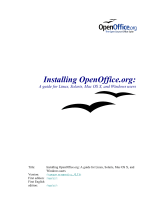
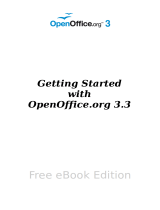
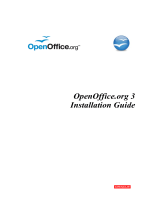
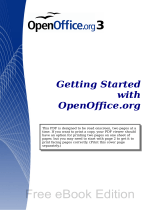
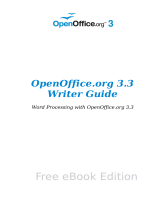

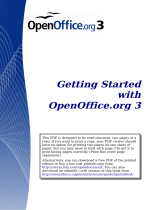



![SuseLinux Professional 9.2 Upgrade [Strong Encryption 128 Bit]](http://vs1.manuzoid.com/store/data/000336272_2-8918b86fe5596dedffb3db1221048e46-160x210.png)
